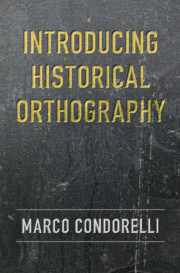Book contents
- Introducing Historical Orthography
- Introducing Historical Orthography
- Copyright page
- Contents
- Figures
- 1 Introduction
- Part I Origins and Sources
- Part II Elements of Orthography
- 4 Orthographic Components
- 5 Structure and Presentation
- Part III Analysing Orthography
- Part IV Understanding Orthography
- Bibliography
- Index
- References
5 - Structure and Presentation
from Part II - Elements of Orthography
- Introducing Historical Orthography
- Introducing Historical Orthography
- Copyright page
- Contents
- Figures
- 1 Introduction
- Part I Origins and Sources
- Part II Elements of Orthography
- 4 Orthographic Components
- 5 Structure and Presentation
- Part III Analysing Orthography
- Part IV Understanding Orthography
- Bibliography
- Index
- References
Summary
Chapter 5 focuses on the most frequent ways in which the orthographic elements established in the previous chapter are organised, following segmental, suprasegmental and morphological structures. Examples include the interrelation between graphemes and other orthographic units, like tildes and accents; the recurrence of graphemes in frequently recurring clusters and the use of ligatures across orthographic units. A short section on the importance of direction (left-to-right, right-to-left, top-to-bottom, etc.) in historical orthography is also provided. The chapter also focuses on the overlap between orthographic structure and the visual aspect of a document, namely the ways in which writing participates in the mise-en-page. This section argues for the importance of a full, physical document as a considerable part of the overall communicative event that is orthography. The visual programme in a given text, namely its layout, decoration and illustration, usually acts as a cohesive and structural tool alongside written marks, such as chapter headings or meta-textual commentary. Lastly, spacing, justification and abbreviation are also discussed.
- Type
- Chapter
- Information
- Introducing Historical Orthography , pp. 82 - 102Publisher: Cambridge University PressPrint publication year: 2022

